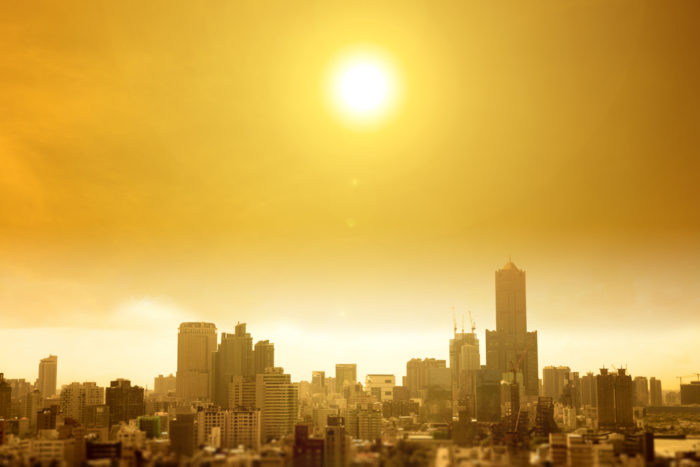
It’s the hottest year on record
July 28th, 2023Thousands of holidaymakers were looking forward to laying in the sun this summer in countries across southern Europe hoping to top up their tan and soak in the feel-good vitamin D.
The hottest year on record, is this the foretaste of the future?
This month, hot sun and stifling temperatures around the world have led experts to be ‘virtually certain’ that it’s been the hottest year on record. Heat waves caused by global warming have left people with heat exhaustion and dehydration. The World Meteorological Organization (WMO) claim this is a foretaste of the future.
Blistering heat waves have caused havoc across the Mediterranean resulting in a mass evacuation of homeowners and holidaymakers. With temperatures over 48 degrees in some countries, it’s never been more important to minimise exposure to the sun and protect your skin.
Sun poisoning
Overexposure to the sun’s UV radiation can cause sunburn. Sun poisoning is an extreme case of sunburn causing swelling, blisters, pain, headaches, fainting or fever. It can induce a rapid pulse rate and cause nausea, vomiting, dizziness, confusion and vision problems.
Your skin can burn within 15 minutes of exposure to the sun’s UV radiation. Those people most susceptible to sunburn are redheads because they don’t produce enough melanin. Melanin absorbs UV light and the skin tans to form a semi-protective layer.
Others at high risk are fair-skinned people from northern climates, people with pre-existing medical conditions such as lupus, eczema or those that suffer from Polymorphous Light Eruption (PMLE).
Medication can also cause sun sensitivity – antibiotics, acne medication, antidepressants, anti-fungal treatments and antihistamines.
Sometimes it is hard to avoid periods of time in the sun or you want to have sun-tanned skin, so what can you do to prevent sun poisoning?
- Be conscious of how long you have been exposed to UV radiation. Take into consideration that it is possible to burn your skin in cooler temperatures where the sun is reflecting off surfaces such as skiing in the snow, swimming in water or being close to surfaces such as glass or mirrors
- Wear sunscreen with a minimum of sun protection factor (SPF) 30
- Reapply SPF protection every 2 hours or each time you come out of the water
- Wear a sun hat to protect the scalp
- Wear sunglasses with UV protection lenses
- Use a sun umbrella to create shade to stop direct exposure
- Seek shaded areas
- Wear clothing with UV protection
- Wear long-sleeved loose tops or long loose trousers
- Choose dark colours which absorb less of the UV rays
- Wear footwear that covers the feet
- Stay hydrated by drinking plenty of water
- Keep your body cool using a fan or air conditioning
- Stay out of the midday sun if possible
It’s easy to burn the skin, so what can you do when it happens, and when should you seek medical help?
Red, hot, tender skin can turn to dry, tight, peeling and itchy skin with overexposure to UV radiation. When you get sunburned, it’s important to stay out of the sun completely. Take a cool shower, and put yourself in a cool environment. A cold compress such as a bag of frozen peas wrapped in a cloth placed on the burnt skin will help to reduce the inflammation, so will taking anti-inflammatory pain relief such as ibuprofen. Keeping the skin moisturised is also important and, there are plenty of products on the market with cooling and healing agents such as aftersun lotion or gel.
In more severe cases of sunburn – sun poisoning, symptoms may be out of your control, such as infected skin blisters or signs of three-degree burns, this is when it is time to seek medical help. Dehydration can be life-threatening and require dehydration IV treatment.
Melanoma cancer is the most common type of cancer in the US. 20 people die every day from skin cancer caused by the sun or tanning beds. If you notice changes in your skin, such as a new mole developing or a mole changing in appearance you should have it checked by a doctor. How can you tell if a mole could be cancerous? Find out more here.
Sun damage and photoaging
Damage to the skin from UV radiation is known as photoaging, photodamage, solar damage or sun damage. When it happens, DNA changes at a cellular level, and the skin ages prematurely causing wrinkles, loss of skin elasticity, sun spots and rashes.
Medical or cosmetic intervention can help in the form of chemical peels, laser treatment, topical medication or cryotherapy.
Foods that can help relieve sunburn
- Carrots – they contain beta carotene which builds up the outer layer of the skin
- Fermented milk – live cultures in fermented milk amplifies DNA cell repair
- Oranges – they contain vitamin C rich in antioxidants that can decrease cell damage
- Tomato-based dishes – tomatoes contain lycopene which provides skin protection
- Pomegranates – they are a rich source of polyphenols which are anti-inflammatories
Prevention is better than cure, so stay safe in the sun.
Have you heard of Curaderm BEC5® cream?
BEC5 cream, also known as Curaderm, is an effective skin cream for sun spots, age spots, Keratoses and Keratoacanthomas.
Find out more here: https://profound-health.com/product/bec5-curaderm/
References
- https://share.upmc.com/2017/06/sunburn-when-to-see-your-doctor/
- https://public.wmo.int/en/media/press-release/july-2023-set-be-hottest-month-record#:~:text=According%20to%20the%20ERA5%20dataset,th%20and%207th%20July.
- https://share.upmc.com/2014/06/dangers-sun-poisoning/#:~:text=Sun%20poisoning%20is%20an%20extreme,severe%20symptoms%20and%20dangerous%20situations.
- https://www.aad.org/public/everyday-care/sun-protection/shade-clothing-sunscreen/what-to-wear-protect-skin-from-sun#:~:text=To%20help%20protect%20your%20skin,open%20weave%2C%20such%20as%20lace.
- https://www.aad.org/media/stats-skin-cancer#:~:text=The%20vast%20majority%20of%20skin%20cancer%20deaths%20are%20from%20melanoma.&text=Nearly%2020%20Americans%20die%20from,5%2C080%20men%20and%202%2C570%20women.
- https://www.yalemedicine.org/conditions/sun-damage





